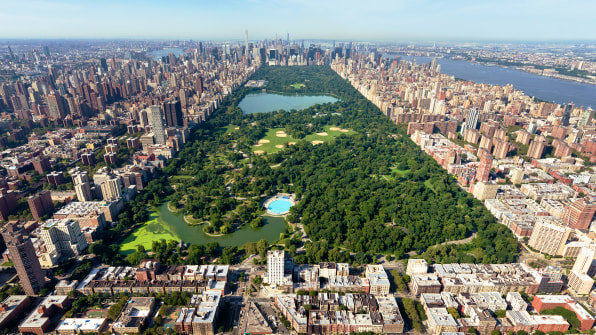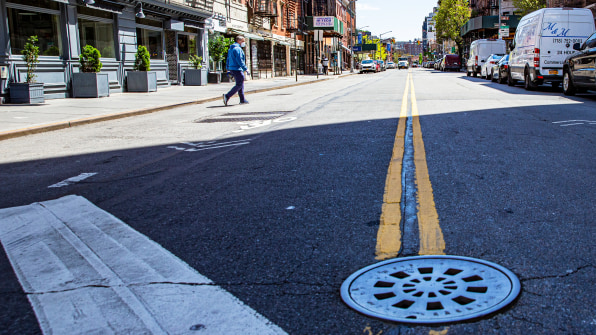Johnson City Water and Sewer Meter Reading Address
Only cities take long had to transform themselves to overcome affliction.
My research on urban planning and communicable diseases traces this design to the founding of the nation.
Xanthous fever and cholera
In 1793, a xanthous fever outbreak in Philadelphia killed v,000 people–about ten% of what was then the U.S. upper-case letter's population. At the time, Philadelphia, similar all American cities, had no municipal garbage services. Hogs roamed streets and ate garbage.
On the advice of prominent doctors who redirected blame for the outbreak away from immigrant communities and toward poor sanitation–presciently, since germ theory had not all the same been invented–Philadelphia'south mayor authorized emergency funding to treat the ill and clean the gutters.
Such efforts were a harbinger of urban planning reforms, equally cities would take on the costly job of garbage removal and create sanitation departments over the next 50 years. These measures profoundly improved residents' health in the brusque- and long-term. They also added alleyways to cities for garbage removal.
When contaminated h2o brought waves of cholera sweeping through the U.S. in the 1850s, cities across the state birthed the twin agencies of public wellness and urban planning to brand and enforce regulations. In the same period, New York City's Board of Health made way for Primal Park–the nation'southward first public park–on the premise that open up urban space improved human and ecology health.
The park housed a reservoir designed to deliver fresh, clean water to the burgeoning metropolis. It received water from ane of the nation's first cracking aqueducts.
For the start fourth dimension, New York's housing development was planned, with growth fastened to funding for sewer and water lines. By 1916, this patchwork of evolution directives was compiled into the U.S.'due south starting time citywide zoning code.
Cities everywhere followed New York'south example, taking control of land utilise and vanquishing waterborne pathogens similar cholera and polio by the mid-1900s.

Battling airborne pathogens
Airborne illnesses, which make up 8 of the ten most recent pandemics, however, are proving difficult to combat.
When Arab republic of egypt faced H1N1 swine flu in 2009, officials in Cairo misdiagnosed the problem, focused on slum clearance and culling pigs instead of breaking homo-to-human transmission. Swine influenza, an airborne illness, contains pig genes but cannot exist transmitted past pigs.
Since many Cairo neighborhoods rely on a Coptic Christian group chosen the Zabaleen to remove waste–which they later feed to pigs–the streets before long filled with garbage. Rat populations boomed. Typhoid, cholera, and other diseases resurged.
Breaking airborne disease transmission requires reducing homo-to-human contact through physical distancing and business organisation closures, for example, and wearing masks to impede infectious aerosol. Shelter-in-identify orders prevent travel-related disease spread.
Considering lockdowns are difficult to maintain over fourth dimension, policymakers are searching for longer-term solutions.
"NYC must develop an firsthand program to reduce density," tweeted New York Governor Andrew Cuomo on March 22, reviving a longstanding argument that density contributes to greater human-to-human contact and illness.

Still while dense major cities are more than likely entry points for affliction, history shows suburbs and rural areas fare worse during airborne pandemics–and after.
According to the Princeton evolutionary biologist Andrew Dobson, when there are fewer potential hosts–that is, people–the deadliest strains of a pathogen take better chances of being passed on.
This "selection pressure" theory explains partly why rural villages were hardest hit during the 1918 Spanish flu pandemic. Per capita, more people died of Spanish flu in Alaska than anywhere else in the country.
For centuries diseases take forced American cities to make such changes–to innovate in means that ended upward benefiting all future residents.
Pandemic-related urban policy advances like ceding more terrain to pedestrians or structurally addressing homelessness take fourth dimension to emerge. My enquiry identifies some reflexive denial early in an outbreak.
But, ultimately, American cities take triumphed over infectious diseases many times before. I'm hopeful nosotros can exercise it once more.
![]()
Source: https://www.fastcompany.com/90506275/sewers-public-parks-clean-water-pandemics-have-actually-made-cities-better
0 Response to "Johnson City Water and Sewer Meter Reading Address"
Mag-post ng isang Komento